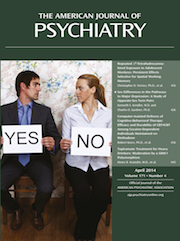Head Injury as Risk Factor for Psychiatric Disorders: A Nationwide Register-Based Follow-Up Study of 113,906 Persons With Head Injury
Abstract
Objective
Studies investigating the relationship between head injury and subsequent psychiatric disorders often suffer from methodological weaknesses and show conflicting results. The authors investigated the incidence of severe psychiatric disorders following hospital contact for head injury.
Method
The authors used linkable Danish nationwide population-based registers to investigate the incidence of schizophrenia spectrum disorders, unipolar depression, bipolar disorder, and organic mental disorders in 113,906 persons who had suffered head injuries. Data were analyzed by survival analysis and adjusted for gender, age, calendar year, presence of a psychiatric family history, epilepsy, infections, autoimmune diseases, and fractures not involving the skull or spine.
Results
Head injury was associated with a higher risk of schizophrenia (incidence rate ratio [IRR]=1.65, 95% CI=1.55–1.75), depression (IRR=1.59 95% CI=1.53–1.65), bipolar disorder (IRR=1.28, 95% CI=1.10–1.48), and organic mental disorders (IRR=4.39, 95% CI=3.86–4.99). This effect was larger than that of fractures not involving the skull or spine for schizophrenia, depression, and organic mental disorders, which suggests that the results were not merely due to accident proneness. Head injury between ages 11 and 15 years was the strongest predictor for subsequent development of schizophrenia, depression, and bipolar disorder. The added risk of mental illness following head injury did not differ between individuals with and without a psychiatric family history.
Conclusions
This is the largest study to date investigating head injury and subsequent mental illness. The authors demonstrated an increase in risk for all psychiatric outcomes after head injury. The effect did not seem to be solely due to accident proneness, and the added risk was not more pronounced in persons with a psychiatric family history.



